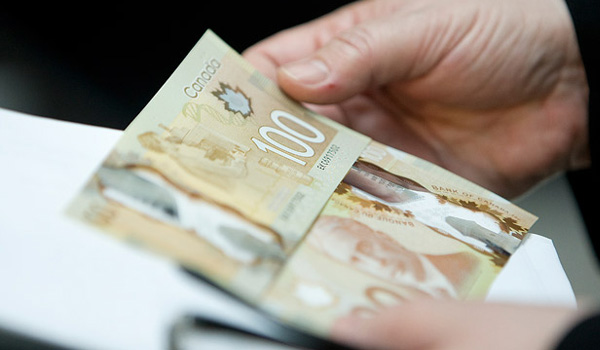大量中国新富拿加国贫穷补贴
A flood of Chinese investors receives social assistance by alleging poverty in tax return
来源: 大中报 南茜(Nancy Jin)

根据加拿大统计局的最新收入调查, 2012年约有460万加拿大人被视为低收入人群。2013年这一比率几乎没有改变,近500万加拿大人生活在低收入阶层。根据加拿大统计局的定义,凡是家庭收入中20%以上用于支付生活必需品(吃穿住)的家庭为低收入家庭。
About 4.6 million people were considered low income in 2012, based on a new Canadian Income Survey from Statistics Canada. The share was barely changed in 2013, when nearly five million Canadians were living in low income. According to StatsCan, families are considered low income if they are spending 20% more of their income on necessities like food, shelter and clothing.
加拿大的纳税人每年花费在社会救助和帮助低收入家庭上的费用为240亿加元。福利救助项目是为了减轻贫困家庭之负担,向食不果腹的家庭提供食品补贴。房屋救助的相关项目旨在为贫困家庭提供住房。牙医和药物救助计划旨在改善贫困人员的健康状况。大学学费补助项目则是为有经济困难的学生提供公平竞争的学习条件。
Canadian taxpayers spend $24 billion a year on social assistance programs that help low-income families to survive the financial hardship. The welfare assistance program is to alleviate extreme poverty by providing monthly income to families unable to put food on the table. The affordable housing programs are designed to provide a roof over their head. The dental and drug plans intend to help improve their personal wellbeing. The college tuition grant aims to level the playing fields for students struggling in poverty.
但一个家庭的收入水平和财富并没有直接的关联,实际上,扣除债务后的净资产值更能说明家庭的财务状况。家庭资产额不仅为家人提供生活上的安全保障,而且为家庭成员的教育,健康和发展铺平了道路。
But a family’s income level and wealth are not directly linked. In fact, the value of assets after deducting debts says a lot about the family’s financial status. It doesn’t just grant security, but also paves a path for education, health and wellbeing.
受到超支消费文化的影响,尽收入颇丰,许多加拿家庭并没有多少资产。根据2015年的统计,几乎一半的加拿大人如果失去工作,连支付三个月的基本生活费的存款都没有。但与加拿大人收入丰厚却资产贫乏形成鲜明对比的,是近年来从中国涌入的新富,他们的收入和资产状况与加拿大当地人士恰恰相反。对于其中许多人来说,他们的可征税收入处于最低点,而其资产水平则高得惊人。
Influenced by an overspending culture, many Canadians are poor in assets, despite earning a comfortable income. Overall, almost half of Canadians don’t have the means to cover basic costs for three months if they lose their jobs, according to 2015 stats. But in a sharp contrast to the income rich and asset poor Canadian demographic, there is a recent influx of new rich people from China where income and assets play an entirely reversing role in their family finance. For many of them, their taxable income falls to the bottom while their asset level is through the roof.
以温哥华的房主为例。 加拿大统计局的数据和媒体报道显示出令人不安的趋势,即在该地区越来越多的低收入人群当中,有许多声称为低收入的人士事实上是高端物业和奢侈豪宅的业主。他们在税表中逃避海外收入并申报贫困 - 有些人甚至领取福利支票,接受免费牙医保健和消费税退税。
Take homeowners in Vancouver as an example. StatsCan data and media reports reveal a disturbing trend that there is a growing number of low-income earners in the region, with many being de facto owners of high end properties and luxury mansions. They did not report their global income and alleged poverty in their tax return – with some even receiving welfare checks, free dental work and GST refunds from the government.
温哥华和列治文西区的豪华高尚地段有部分房主,其所报收入和长期处于贫困状态的温市中心东区居民一样低。据加拿大统计局介绍,超过30%居住在绿树成荫的高档地段,并拥有房产值在200万到600万加元之间的居民在税表中申报低收入。卡尔加里大学的一项研究发现,温哥华市约有25,000个家庭所报收入低于其住房开销。
Some homeowners in tony parts of the west side of Vancouver and Richmond were claiming to have income as low as people struggling in Vancouver’s chronically impoverished Downtown Eastside. According to StatsCan, over 30 percent of residents in Metro’s upscale, tree-lined neighbourhood, where properties were selling in the $2 million to $6 million range were reporting low-income. A University of Calgary study has found that about 25,000 households in the city of Vancouver declares less income than they spend on housing costs.
这些低收入申报人中很大一部分是通过商业投资计划来到加拿大的中国投资者。他们有足够的财力支付投资移民项目所要求的80万加元投资资金。据加拿大统计局统计,许多生活在加国统计局“低收入”社区的居民持有中国国籍,占桑拿斯-亚布特斯岭社区人口的50%,占奥克里奇购物中心以南人口的70%。他们把钱储存在温哥华的房地产业上,然后又回到中国工作,去赚取海外收入。
A significant portion of these low-income claimants were Chinese investors who came to Canada through the business investor program. They were wealthy enough to put down $800,000 investment funds required by the program. According to StatsCan, many residents in several of StatsCan “low income” neighbourhoods have a Chinese nationality, which made up 50 per cent of the population in the Shaughnessy-Arbutus Ridge and 70 per cent in south of Oakridge shopping center. They parked their money in Vancouver real estate but went back to work in China to earn a global income.
中国投资者或许有某种不愿披露个人资产的文化特征。但根据税务律师,许多人抓住了加拿大政府的法规漏洞,并非法地向税务部门逃避申报其海外收益。
While the non-disclosure of assets by Chinese investors can be traced to their cultural trait of keeping personal assets private, many were taking the loopholes in the government regulations and acting outside of the law by not reporting the overseas earnings, according to tax lawyers.
这些富裕的中国投资者逃避他们理应支付的公共服务份额。 他们与加拿大无家可归的人和边缘化人士争抢社会福利,试图那些勤奋工作和遵守法规的加拿大纳税人所贡献的有限资源中分得一杯羹。这种行为实为不耻。
It’s a shame that those wealthy Chinese investors avoid their fair share of payment for the public services. They compete with Canada’ homeless and marginalized people for the limited financial resources contributed by the responsible and hardworking Canadian taxpayers.
网友评论
网友评论仅供其表达个人看法,并不表明大中资讯网立场。评论不可涉及非法、粗俗、猥亵、歧视,或令人反感的内容,本网站有权删除相关内容。